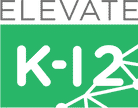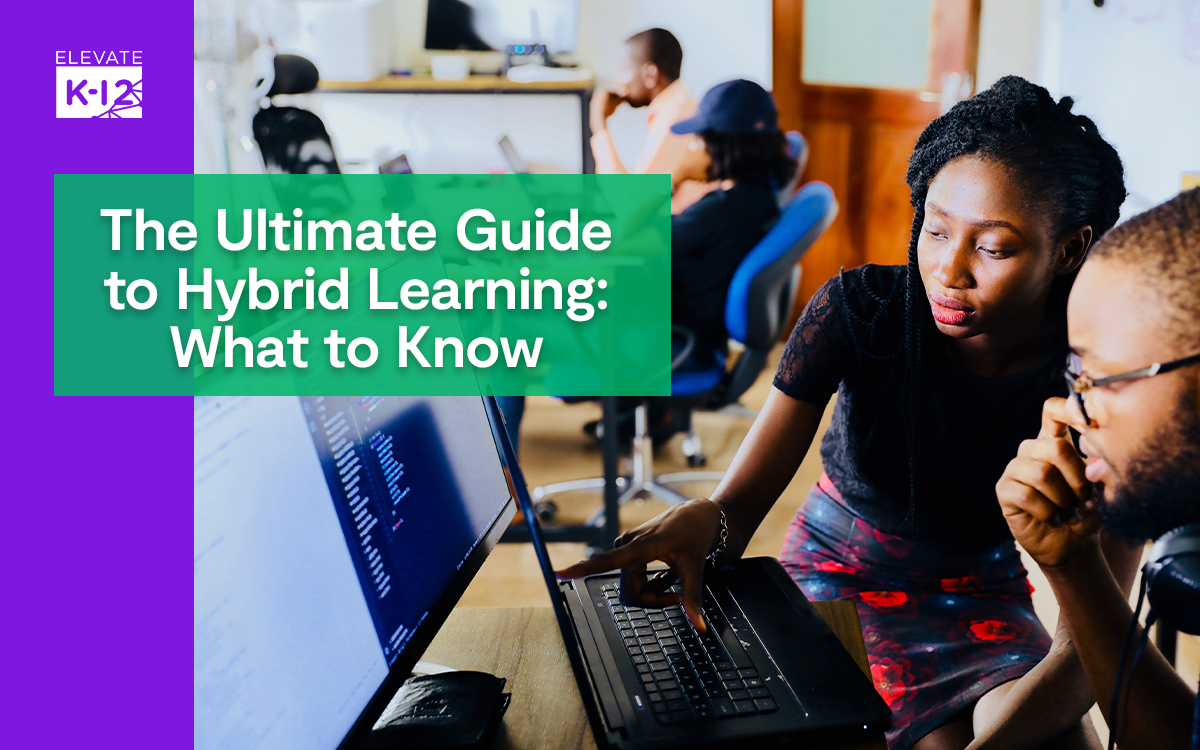School district officials (and the educators they lead) have endured a turbulent half-decade. The pandemic disrupted traditional education delivery models seemingly irreversibly. Ongoing staffing challenges and teacher shortages remain high in districts across the country.
One model that has skyrocketed in popularity in response to these tumultuous changes is hybrid learning. Not entirely traditional in-person instruction and not fully remote “Zoom school,” hybrid learning occupies a middle ground.
It’s a divisive subject and still lacks a clear consensus: Is hybrid learning the best of both worlds? The worst of both? Or somewhere in the middle as a viable though imperfect alternative?
And perhaps the best question of all: Is there a better version of hybrid learning that stands out from the rest?
What Is Hybrid Learning?
In the context of K-12 education, hybrid learning is any instruction model that combines both face-to-face and remote or virtual learning methods. This mix can take many forms, but the critical distinction is that hybrid learning is neither 100% in-classroom nor 100% remote.
Today’s hybrid learning grew from earlier iterations, such as flipped classrooms and blended learning environments. Though you’ll see these terms used similarly, the three have subtle yet fundamental differences.
The Flipped Classroom model traces back to around the year 2000 (though elements of it are even older), where students learn core subject matter outside the classroom (such as via video, now almost exclusively delivered online) and then use in-classroom face-to-face instruction for problem-solving and discussion.
Blended learning emphasizes asynchronous remote learning paired with in-person teaching (often enhanced with technology).
As technology evolved and internet access expanded, hybrid learning grew out of these, enabling two new possibilities:
- Teachers could simultaneously instruct in-person and remote students.
- Live, remote teachers could teach students synchronously (in real-time), whether students are at home or in a hybrid classroom.
The first type, which surged in popularity in the post-pandemic years, is attractive in its flexibility but has some practical flaws.
The second approach, fully live learning delivered in a hybrid model, is the superior choice, as it allows districts to connect with teachers in hard-to-fill niches and eliminates the “multitasking” distractions of in-classroom teachers trying to manage two very different groups (and delivery methods).
What Are the Benefits of Hybrid Learning?
Hybrid learning (specifically the method offered by Elevate LIVE) offers several tangible benefits to schools and school districts throughout the USA. Here are just a few of them.
Flexibility
Hybrid learning environments provide greater flexibility than traditional classroom education (or any other available model).
With hybrid teaching, this flexibility shows up in numerous ways:
- Students may learn within the most conducive setting, giving diverse learners greater opportunities.
- Teachers gain flexibility in how they provide instruction and assess student learning.
- Teachers can further customize instruction and adapt their modes and methods of teaching.
- In asynchronous approaches, students and teachers gain immense schedule flexibility.
Accessibility
Hybrid learning can also increase accessibility to education, particularly for students in remote areas or with varying abilities.
In less densely populated areas where lack of accessible travel can hinder education, a hybrid learning model can reduce the frequency of in-person, in-classroom instruction. Some students with special needs may also benefit from a remote or hybrid instruction model that reduces in-classroom interactions and allows the student to focus on learning from home or an alternate location.
Of course, this relies on one or more digital platforms, learning software, and systems that can help bridge opportunity gaps.
Technology
Technology powers hybrid learning activities, and the technology itself can be a great way to help students become more engaged with and excited about learning and specific lessons.
Today’s students are immersed in technology regardless of their learning experience. The digital ecosystem and landscape are, in many ways, the “language” they speak as they spend surprising amounts of their lives behind a screen. (Middle and high school students spend over eight hours per day using screens—and that doesn’t include screen time related to education or educational pursuits!)
So, it’s possible that in shifting learning toward this new reality, educators can improve learning engagement through technology.
Personalized Learning
Hybrid learning also better supports personalized educational paths. Differentiated instruction certainly isn’t new, nor is it reserved for hybrid models. But Elevate K-12’s LIVE teaching model makes differentiated instruction even more natural and effective.
For example, an in-classroom paraprofessional can help address one-on-one questions and reinforcement, while the LIVE remote teacher focuses on group instruction. For small-group learning, remote and in-classroom personnel can break up the load in similar ways.
Adaptive technologies can also help meet individual student needs. For example, audio recorders, recorded lectures, and video content can be immensely helpful for students with differing learning needs. They can rewatch or listen to the content as much as needed for additional reinforcement.
More Collaboration
Hybrid learning is also inherently a collaborative modality, which helps students develop valuable interpersonal communication skills. Whether in physical or digital spaces, students learning via hybrid learning must collaborate and interact with peers and teachers in unique ways that may stretch and grow their capabilities in this area — and their emotional intelligence as a result.
Potential Challenges of Hybrid Learning
We’re firmly convinced of the value of hybrid learning, especially when executed in powerful, technology-forward ways that prioritize education quality. That said, the model can lead to certain challenges.
Keep the following potential challenges in mind — and if you see them growing out of proportion, consider evaluating whether your chosen hybrid model is serving you as effectively as possible.
Coordination Complexity
Any hybrid model comes with a level of coordination complexity, with teachers juggling in-person and remote students in the same teaching session. Integrating these online and offline populations effectively is equal parts art and science, requiring a level of coordination and technology literacy that a traditional, all-in-person classroom teacher doesn’t have to worry about.
Scheduling can also be complex, as can communicating expectations to students and their caregivers.
Many hybrid approaches rely on paraeducators and other non-teaching staff to bridge gaps and help with classroom coordination. This approach is strong and logical; however, each additional person adds another layer of communication complexity to the mix.
Resource Intensive
Hybrid learning requires notably more resources than a traditional classroom, including technology infrastructure (both in the classroom and in students’ homes). Professional development for educators may be needed (these discrete skills and techniques are not always obvious or intuitive for all educators), and many hybrid classrooms will need more paraprofessional support than their traditional counterparts.
Of course, in some circumstances, these additional resources are easier to come by than additional credentialed teachers.
The increased resource needs may be easier to overcome in some situations, such as hard-to-staff positions (e.g., special education) or geographically challenging districts (such as exurban and rural districts, which lose teachers to larger and more well-funded schools in bigger towns and cities).
Varied Teacher Workload
Teacher workload in various hybrid models will vary, sometimes exceeding the workload a teacher may be accustomed to. This can be especially challenging for teachers managing a split population of in-person and remote students.
Solutions to the workload challenge include these:
- Training
- Technology
- In-classroom support (paraeducators)
How Is Hybrid Learning Different From Other Models?
Hybrid learning differs from traditional in-class and fully online learning models, carrying a different set of pros and cons.
Although in-classroom instruction is tried and true, it can have staffing limitations, accessibility challenges, and more.
Fully online learning is possible, but engagement remains a sticking point for many: The lack of live, face-to-face interaction can be challenging for students and teachers alike.
Completely virtual synchronous learning may lead to video conferencing fatigue and a lack of real-life interaction between students. We all saw the challenges with this during the COVID-19 pandemic, and it isn’t something many people want to continue as a long-term sole strategy.
Asynchronous virtual learning (essentially the distance learning model borrowed from higher education) has similar drawbacks — static recorded lectures leave little to no opportunity for interaction with peers or teachers.
There’s also the question of access. It just isn’t correct to assume that all students have the kind of safe, reliable, high-speed internet access required for this model to work. A full 3% of school-aged children have no internet access at home, and 7% don’t have access through a computer—and this doesn’t even touch on students from unhoused families.
A Better Alternative: Live Streaming Instruction
Live streaming instruction, a subset of hybrid learning, is emerging as a highly relevant and attractive option in K-12 education.
With Elevate K-12’s LIVE teaching, schools and districts gain access to fully remote, fully credentialed, fully trained teachers in whatever subjects and disciplines they need (including special education teachers in most states). This isn’t asynchronous instruction or impersonal lecture content — we provide LIVE, interactive teaching from real educators specially trained in remote teaching.
Explore what it looks like to elevate your class offerings with LIVE teachers.
The Future of Hybrid Learning in K-12 Settings
Successful hybrid learning is an evolving discipline. New and more powerful technologies are continuously developing that will shape the future of the learning format.
For example, in an age of generative AI tools, it’s only a matter of time before we have AI-powered tools for creating differentiated learning materials that adapt coursework to meet individual student needs.
Further advancements in virtual and augmented reality could redefine the student experience and further blur the line between remote and in-person instruction. Look at Apple’s Vision Pro. It’s pretty cost-prohibitive right now, but it’s also tremendously exciting as an example of what could be possible in the classroom (or virtual classroom) in 10–15 years.
Embracing the Path Forward in Education Models
Hybrid learning is a vital education model as schools and districts look to the future, but the model is undergoing a bit of an identity crisis. Any discussion of hybrid learning has to start by defining the terms — there’s no consensus among professionals, academics, technology partners, and classroom teachers on what exactly the term describes.
While hybrid learning (no matter the form) offers some advantages over in-classroom and fully remote learning, it also has its challenges — many of which can be reduced or eliminated entirely by a LIVE remote teaching approach.
Elevate LIVE brings highly experienced teachers to your school and your district, 100% remote and ready to provide high-quality in-classroom instruction to your students.
Learn more about Elevate K-12’s LIVE teaching difference: Explore now.

